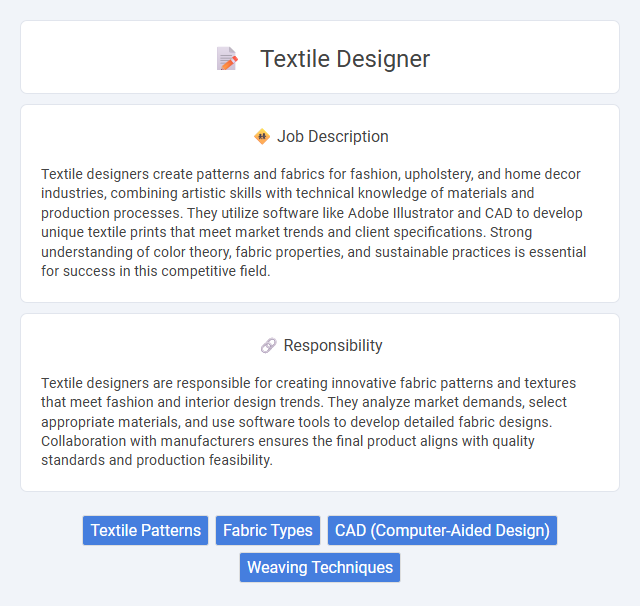
Textile designers create patterns and fabrics for fashion, upholstery, and home decor industries, combining artistic skills with technical knowledge of materials and production processes. They utilize software like Adobe Illustrator and CAD to develop unique textile prints that meet market trends and client specifications. Strong understanding of color theory, fabric properties, and sustainable practices is essential for success in this competitive field.
Textile designers may likely thrive in environments that value creativity, attention to detail, and patience, as the job often requires working with patterns, fabrics, and colors for extended periods. Individuals who enjoy artistic expression and have a strong sense of aesthetics are probably well-suited for this role, while those who prefer fast-paced or highly physical work might find it less fitting. The job might also require collaboration and adaptability, making it more suitable for those comfortable with feedback and iterative design processes.
Qualification
A textile designer must possess a strong foundation in art and design, typically demonstrated through a bachelor's degree in textile design, fashion design, or a related field. Proficiency in design software such as Adobe Illustrator and CAD systems is essential for creating detailed patterns and fabric prints. Knowledge of fabric types, production processes, and color theory enhances the ability to develop innovative, market-ready textile products.
Responsibility
Textile designers are responsible for creating innovative fabric patterns and textures that meet fashion and interior design trends. They analyze market demands, select appropriate materials, and use software tools to develop detailed fabric designs. Collaboration with manufacturers ensures the final product aligns with quality standards and production feasibility.
Benefit
Textile designers likely enjoy benefits such as creative fulfillment, competitive salaries, and opportunities for freelance work or collaboration with fashion brands. The role may also offer access to cutting-edge design software and industry events, enhancing professional growth. Networking within the fashion and manufacturing industries could further increase job prospects and personal development.
Challenge
Textile designers likely face the challenge of balancing creativity with technical constraints, such as fabric properties and production methods. They may need to anticipate market trends while ensuring their designs are feasible for mass manufacturing. Meeting tight deadlines without compromising innovation could also be a frequent difficulty in this role.
Career Advancement
Textile designers can advance their careers by developing expertise in digital design software and staying current with emerging fabric technologies. Building a strong portfolio showcasing innovative patterns and sustainable materials enhances visibility to top apparel and interior design firms. Networking within industry trade shows and securing certifications in textile science propel designers toward roles like senior designer, design director, or product development manager.
Key Terms
Textile Patterns
Textile designers specializing in textile patterns create innovative and visually appealing designs for fabrics used in fashion, home decor, and industrial applications. Their expertise in color theory, fabric textures, and digital design tools allows them to produce patterns that enhance the aesthetic and functional qualities of textiles. Mastery of trend analysis and cultural influences is essential to developing unique motifs that resonate with market demands and inspire consumer engagement.
Fabric Types
Textile designers specialize in creating innovative patterns and textures for various fabric types, including cotton, silk, wool, and synthetic blends. Their deep understanding of fabric properties ensures the designs complement the material's durability, flexibility, and aesthetic appeal. Proficiency in digital design tools and knowledge of sustainable textiles are essential for producing market-ready fabrics that meet industry trends and consumer demands.
CAD (Computer-Aided Design)
Textile designers specializing in CAD (Computer-Aided Design) utilize advanced software such as Adobe Illustrator and AutoCAD to create intricate fabric patterns and textures, enhancing precision and efficiency in design processes. Mastery of CAD tools enables designers to quickly modify and visualize textiles digitally, facilitating rapid prototyping and customization in fashion and interior design industries. Expertise in CAD technology significantly contributes to innovative textile development, reducing production time and optimizing material use.
Weaving Techniques
Textile designers specializing in weaving techniques create intricate patterns and textures by interlacing threads using methods such as plain weave, twill, and satin. Expertise in loom operation and fabric structure enhances the development of innovative textiles for fashion, interior decor, and industrial applications. Mastery of color theory and material properties ensures the production of durable, aesthetically appealing woven fabrics.
 kuljobs.com
kuljobs.com